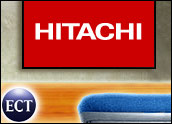
Hitachi Global Storage Technologies (Hitachi GST) has developed the world’s smallest read-head technology for hard disk drives, which the company expects will let it deliver small form-factor hard drives with up to four terabytes of space for desktop PCs and up to one terabyte for notebooks.
The leap, which Hitachi projects will occur by 2011, would quadruple the current storage capacities of today’s PCs. The company announced its breakthrough at the 8th Perpendicular Magnetic Recording Conference at the Tokyo International Forum in Japan Monday.
The Tiny Details
Hitachi researchers have reduced existing recording heads by more than a factor of two to achieve new heads in the 30 to 50 nanometer (nm) range, which is up to 2,000 times smaller than the width of an average human hair, Hitachi said. Called “current perpendicular-to-the-plane giant magneto-resistive (CPP-GMR)” heads, Hitachi’s new technology is important because the continued advancement of hard disk drives requires that increasingly smaller data bits get squeezed onto the recording media, allowing for greater data storage and “bigger” hard drives.
The problem with shrinking recording heads, however, has been in a relative increase in electrical resistance, which creates noise that makes it hard for the head to correctly read data. Hitachi’s CPP-GMR device reduces electrical resistance, according to the company, resulting in lower electrical noise and signals that can still be accurately read by the recording heads.
Nobel Prize Link
Incidentally, Albert Fert and Peter Grnberg were last week named the recipients Nobel Prize in physics for 2007 for the discovery of GMR.
“This year’s physics prize is awarded for the technology that is used to read data on hard disks. It is thanks to this technology that it has been possible to miniaturize hard disks so radically in recent years,” the Royal Swedish Academy of Sciences noted upon announcing the prize winners.
Putting the prize in perspective, “This quadrupling of density is a great example of the continuing evolution of drive technologies — it’s great that it comes after the Nobel award last week,” Charles King, principal analyst for Pund-IT, told TechNewsWorld.
“The funny thing about the IT space is there’s so much attention lavished on the processor vendors, and for good reason — processors drive the vast majority of computing devices — but without effective storage, the work of the processors becomes moot,” he explained. “To my mind, the importance of storage is equal to, if not more important to, what we hear from the processor vendors on a regular basis.”
HDD vs. SSD
While Hitachi is apparently making leaps in hard disk drive (HDD) technology, the company as well as many of its competitors are also investing in Solid State Design (SSD) hard drive technology. SSD is typically based on flash memory. SSD drives are much smaller (in the range of 32 to 64 GB), more expensive and faster.
“Hitachi continues to invest in deep research for the advancement of hard disk drives, as we believe there is no other technology capable of providing the hard drive’s high-capacity, low-cost value for the foreseeable future,” noted Hiroaki Odawara, research director of Hitachi’s Storage Technology Research Center. “This is an achievement for consumers as much as it is for Hitachi. It allows Hitachi to fuel the growth of the ‘Terabyte Era’ of storage, which we started, and gives consumers virtually limitless ability for storing their digital content.”
Consumers, it turns out, are key drivers behind Hitachi’s efforts.
“It used to be more of the corporate environment that was driving most of the capacity needs in disk drives,” Jeff Janukowicz, IDC’s research manager of SSD and HDD components, told TechNewsWorld. “Now we’ve seen a transition of that over to the consumer. Digital video, digital cameras, MP3 — all this explosion of digital content at the consumer level is driving the needs for more capacity.”
Will SSD Catch Up?
“We think HDDs are going to keep the lead in terms of capacity,” Janukowicz noted. “It’s certainly going to be some time before solid state memory will catch up at all. This Hitachi announcement is another reason why we think hard drives will keep a good pace to retain that difference with [SSDs] from a capacity perspective,” he added.
One question remains with any new technology announcement: “Can they deliver?”
“Hitachi has a great deal of drive expertise, but when they bought IBM’s hard drive business [in 2002], there were some questions about how well Hitachi would be able to continue to drive the kind of innovation that was common from IBM,” King said.
“I think this new announcement is a good measure of that,” he noted. “They are taking the latest and greatest evolutionary steps in hard drive development and are applying them in a commercial sense. The concept of a four-terabyte drive is pretty phenomenal when you sit down and think about it.”



















































